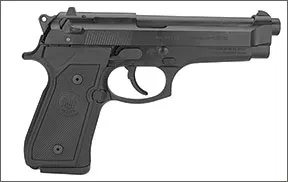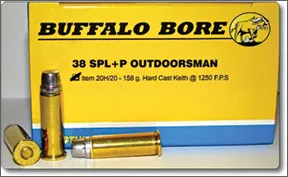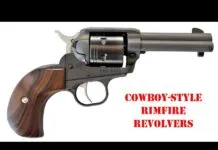Re “257 W’by Bolt Rifle Match-Up: Vanguard 2 Beats
the Mark V,” April 2013
Without a doubt, Gun Tests is at the pinnacle of all publications dedicated to evaluating firearms and related articles, and I look forward to each issue. The April 2013 issue pitting the Weatherby Mark V against the Vanguard 2 was a splendid idea, for which I have a few comments, as I feel qualified to do so. As a Weatherby collector owning many Mark V’s and Vanguards (but no Vanguard 2s) as well as at least one of each in a 257, and having built custom rifles with these actions to include pillar bedding the front and rear (yes, it can be done with some ingenuity), glass bedding, etc., there should be no play whatsoever with the magazine box, which also may account for the problems feeding with the first round. The box is designed to fit in one direction and should be sandwiched firmly between the bottom metal, not the floorplate and the receiver. If the magazine box is inserted incorrectly, play can occur. When the floorplate is closed, that eliminates the play, or the stock dimensions are off and tightening of the receiver screws does not engage the magazine box. Of all of the Mark V’s I own, I have never seen the problem unless I have put one back together incorrectly and put the magazine box in wrong. I hope this helps. Thanks.
— Dolphin Overton
Wilson, NC
I’d like to recognize the Gun Tests reader who submitted the original story idea for this feature. Joel Pipkin, writing from Kandahar, Afghanistan, said in an October 2011 email: “Hello from Afghanistan. I am a current subscriber to your magazine, and so far I have been happy with the articles and tests you have done. It is quite nice to read a magazine that does testing and doesn’t hold any punches. I would like to request a test, and see it in your magazine in the near future if possible. I own two Weatherby Mk V’s, and they seem to be great rifles and are my favorite hunting rifles. No, I am not trying to win a fashion show in the woods; however, I do like the feel of wood on my hunting rifles. I would like to see a test done by you between the Weatherby Mk V and the Wal-Mart Weatherbys. As with most people, I do not like to get ripped off and would love to see the comparison between the low-end Weatherbys and the high-end Weatherbys. I have noticed a lot of the Wal-Mart Weatherbys have the “sub-MOA” sticker on them, and I want to know if the Mk V’s can shoot as well, and if they shoot better. As expensive as the Mk V’s are compared to the Wal-Mart Weatherbys, I would like to think so.” And as Ray Ordorica’s research pointed out, the Vanguard 2 did indeed shoot as well as the more expensive Mark V for about half the money.
— Todd Woodard
Re “Mosquito Bites?
Firing Line,” March 2013
I had the same frustration with the Sig Mosquito I bought for my wife. Failures to extract and stovepipes made her hate the Sig. I tried lubes, repeated cycling, and Flitz polish, to no avail. I sent the gun back to Sig and they promptly returned it with a re-bore. Problem solved! It’s now the gun it should have been from the start. Fun, fairly accurate, cheap to shoot, and most important, reliable.
— Ness “Rick” Gray
Matthews, NC
Gunsmith Recommendation
I recently purchased a Smith & Wesson PPK/s 380 ACP. The decocker is hard to rotate. Is there a gunsmith in my area you could recommend to work on my PPK/s?
— David in Houston
Jack W. Everett’s shop, Jack’s Gun Shack, is located inside Tactical Firearms in Katy, Texas. Email him at info@jacksgunshack.com or call 281-846-GUNS (4867). — tw

Re “Boot-Gun Revolver Showdown: 38 Specials
Take on 9mms,” March 2013
Just read your 38 Special vs. 9mm revolver comparison. The stats on the “Buffalo Bore Outdoorsman Hard Cast Bullet +P 420H/20” really caught my eye. What is it that allows this load to achieve 505 foot-pounds? This one load definitely skews the averages when comparing the revolver loads. BTW, I have a Taurus 905 9mm revolver and love it. It’s a great range gun because I can load 10 moon clips before leaving home and shoot all I want to fairly quickly. Also, its a great bedside gun, but it’s a little heavy for concealed carry, in my opinion.
— Sam Williams
Ocala, Florida
Yes, Buffalo Bore’s top-end loads carry some whack. That energy reading is the result of math, a 158-grain projectile launched at 1200 fps. The manufacturer’s notes about the load are interesting. From the Buffalo Bore website: “This load was designed for those who need a deep-penetrating 357 Mag. or 38 Special load to be fired from lightweight-alloy 357s and any 38 Special revolver. Lightweight-alloy 357s develop multiple problems when firing our 180-grain 357 Mag. hard-cast turbocharged (Item 19A) ammo or any make of full-power 357 ammo. Yet many folks want a deep-penetrating ‘outdoor’ type of load for their lightweight pocket 357s, so here it is. Whether you are shooting ‘gators or bears in the head, this load utilizes a hard flatnosed bullet, at sufficient velocity, even from 2-inch barrels, to fully penetrate either. This load is safe to shoot in all 38 Special and 357 Magnum firearms of modern design that are in normal operating condition. In the super-light revolvers (around 11-12 ounces), the bullet will not jump crimp under recoil, provided you do not subject an unfired round to more than five or six firings. In all steel guns, even short-barreled ones, crimp jump is not an issue because the all-steel snubnosed revolvers are much heavier than the alloy versions.…” — tw
Grades for Two 9mms?
I am a subscriber to Gun Tests. Have you tested the FNH Model FNS9 and the Beretta 92FS? If so, could you tell me which grade they received.
— Paul Gabriel
Paul: As a subscriber, you’ve paid for access to the Gun-Tests.com archives. The latest test we’ve done on the 92FS was in June 2003. Part of that evaluation said, “At least two features make the Beretta 92 pistols unique. One is that the slide exposes most of the barrel, and the other is that lockup is almost entirely achieved from underneath the chamber. A barrel-mounted falling locking block accomplishes lockup. This adds to the simplicity of field-stripping. On the left side of the frame is a button that when pushed allows the catch on the other side of the frame to rotate and release the slide. There is no slide stop to remove. Once removed, the top end breaks down to slide, barrel with locking block attached, and the recoil spring with the guide rod. The recoil spring is a single-filament coil, and the guide rod is polymer. This combination allows this pistol to be reliable with low slide mass and reduced recoil.” And then the rating (prior to grading system) was, “Beretta 92FS 9mm, $676. Our Pick. Performance varied from good to excellent, depending on the ammunition.” That would be a Gun Tests Grade: A result today. To see other 9mm tests, log on to Gun-Tests.com, then go to the “Compare Guns” tab. Then narrow your search as you need to. We’ve reviewed dozens of 9mm handguns over the years. But we haven’t gotten to the new FNS9 yet. — tw
Re “Three-Way Handgun Showdown: Springfield,
Chiappa, and Kahr,” December 2012
Thanks for testing the Chiappa Rhino. Despite the write-up, I bought a 5-inch Rhino for my son. My wife and I liked the ergonomics on the Rhino so well (odd that some of your staff didn’t — that’s a pretty comfortable gun to hold), we ended up trading in her 2-inch SP101 for a 2-inch Rhino. The Rhino is actually smaller than the 2-inch Ruger SP101 and virtually identical in size to my Kahr PM45. I think the weights are also very similar, which makes the Rhino very easy to carry and conceal. We experienced no misfires in the first 50 rounds. I didn’t notice that the pistol was inaccurate; my wife was hitting soda cans at 10 yards with regularity, and she’s an infrequent shooter. I don’t think the gap on the rear sight was problematic. Especially for a pistol that might be used at ranges up to 7 yards. I think the only downside so far is the cocker is a little stiff for putting it into single action, but I expect that will loosen up with use. The upside for me is that now my wife doesn’t mind shooting 357 Magnums, and I don’t have to bother buying or reloading 38 Specials any more.
—John Giersdorf
Sierra Vista, Arizona

Re “Compact Polymer 45s: We Pit Glock and
Springfield Armory,” January 2013
I wanted to let you know I love your magazine. It’s one of three I read religiously. Isn’t the Glock 36 a “subcompact” and the XDM 3.8 a “compact?” Wouldn’t a comparison between the XDM 3.8 and the G30 be a more fair and even test? Also, the article comparing the 38 Super to the 9mm and the 10mm was awesome. I am a huge fan of the 38 Super and would love to see more articles on it. Keep up the fantastic work.
—Brian L. Shanholtz
Newport News, Virginia
The XDM 3.8 fires from a barrel just 0.20 inches shorter than the XD Service model. The XDM 3.8 is called a compact by the manufacturer based on its ability to be shortened at the grip. With the full-length magazine and grip extension in place, it is a high-capacity house or service pistol. In my view, a better word to describe the XDM 3.8 would be convertible. The G36 is not referred to as compact by the manufacturer. Glock calls it a Slim Line pistol. Barrel length is listed as 3.78 inches, the same as the G19, which Glock calls a Compact. The Glock 30 does have about the same barrel length (listed at 3.77 inches), but due to its short grip, with no manufacturer endorsed or supplied option, the G30 is a true subcompact and is designated as such by the manufacturer. Sometimes, it doesn’t pay to read the names. The fact is that the XDM 3.8, despite its short-grip option, and the G36 are just about the same in terms of size and ergonomics. Sometimes, we find it appropriate to mix and match calibers if the guns might be considered for the same role and the test is written from that point of view. Thank you for writing. — Roger Eckstine
Re Assault Weapons Ban of 2013
The Assault Weapons Ban of 2013 (Senate Bill S.150), is also aimed at semiauto pistols. It would ban most centerfire semiauto pistols. Look up the definition of the term “semiautomatic assault weapon” from S.150, page 3, line 17 – “Assault Pistol”: (D) A semiautomatic pistol that has the capacity to accept a detachable magazine and any 1 of the following: (i) A threaded barrel; (ii) A second pistol grip; (iii) A barrel shroud…. This section would ban virtually all centerfire semiautomatic pistols. The wording “has the capacity to accept” would be wide open to the anti-gun enforcers. Any pistol with a Picatinny rail has the capacity to accept a second pistol grip. Most pistols with a non-fixed barrel have the “capacity to accept” a threaded barrel. This would include 1911s, Glocks, Springfields, Sigs, Beretta, S&W, H&K, etc. About the only legal centerfire pistols would be the P38(P1), Luger P-08, and some fixed-barrel blowback-type 380s, 32s, and 25 ACPs. This is terrible bill — let’s work to ensure it goes nowhere!—Jim Bulkeley
Sandy, Utah
Senate Majority Leader Harry Reid has told Sen. Diane Feinstein that the semiauto ban bill would not be considered as part of the main gun-control bill, which was to be voted on in April. Reason: He couldn’t find 40 votes for it in the democrat-controlled Senate. However, he told her that she could offer the S.150 language as an amendment to the main bill. Looks like the push is headed toward universal registration, i.e., no private transfers. — tw





























